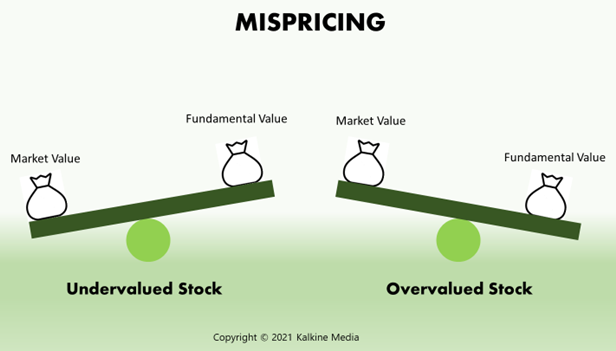What is Mispricing?
Mispricing of a security is the difference between the security’s market value and its fundamental value. The concept of mispricing is against the ‘Law of One Price’, which requires that the price of a security or an asset be the same globally.
The market price of a security can differ from its fundamental value due to a financial crises or a current event in the economy. These shifts can give rise to arbitration opportunities, where security is bought in one market and sold simultaneously in another market at a higher price.
Mispricing, in some circumstances, can be observed as justifiable due to real and economic changes. For instance, during the dotcom bubble of 1999-2000, stock prices of internet startups rose higher than their original value.

What can lead to a difference between current price and fundamental price of the same security?
The market price of an asset can differs from its fundamental or original value due to liquidity, financial and capital constraints.
- The inability of the participants available in a market to obtain funds can lead to mispricing of the asset. Shortage of funds, however, does not permit an investor to arbitrage the security.
- It is suggested that there is a positive correlation between the asset prices and the capital provided by certain financial intermediaries like mutual funds, investment banks, etc.
- Mispricing can occur due to the slow movement of capital investments.
- The inability to sell stocks or securities without incurring a significant loss also leads to mispricing of the security.
Summary
- Mispricing of a security is the difference between the security’s market value and its fundamental value.
- Mispricing, in some circumstances, can be observed as justifiable due to real and economic changes.
- Mispriced securities can be identified using some techniques like relative valuation, technical analysis and intrinsic valuation.
Frequently Asked Questions (FAQs)
- How can mispriced stocks be identified using relative valuation?
Investors always try to maximize their capital gains by identifying mispriced stocks in the market. These stocks could either be overvalued or undervalued. Investors often show interest in undervalued stocks in the hopes to get long-term gains, while overvalued stocks could bring gains in a short-term period.
The relative valuation method compares two or more stocks by using financial ratios and valuation multiples. Some of them are discussed below:
- P/E Ratio: The price-to-earnings ratio depicts the investor's expectations to invest in a company to earn one dollar of the company’s earnings. Observing the company's investment opportunities and the trend of the P/E ratio can also help choose the right stock. When the current stock price does not match with this ratio, it is said to be mispriced. If company A’s current stock price is 60 times its earnings, then it is considered overvalued as compared to company B’s stock, which is 20 times its earnings.
- P/B Ratio: The price-to-book ratio shows how the market perceives a stock by comparing the market price of the stock with its book value. In case the P/B ratio is under 1, the scrip is counted as undervalued.
- EV/EBITDA: The enterprise value, when compared to earnings before interest, tax, depreciation, and amortization, measures the company’s overall performance to its total value. If the EV/EBITDA ratio is more than 1, then the company is overvalued. Ten is considered as the healthy ratio.
- How can the mispriced stocks be identified using intrinsic valuation and technical analysis?
Intrinsic valuation is the calculation of a stock’s worth using a financial model. The investors can see if the stock is overvalued or undervalued by deploying the models like discounted cash flow model, residual income models, etc.
Under technical analysis, the investors analyze the stock’s value by understanding the behavior of buyers and sellers in the market. These investors assume that all the stock’s relevant information is already present in the current market pricing.
- What are the common ways of causing shares to be mispriced?
Some of the common causes of shares being mispriced are as follows:
- Underestimating the returns of a company: Underestimating the growth of earnings of the company earned by running the business is one of the important reason for shares being mispriced. For instance, when one of the business division is being rolled out. The investors can focus on the remaining business’ performance instead of focusing on the division rollout.
- Consumer preferences: Businesses are required to alter their products and services as per consumer preferences. The stock prices can also get hampered if the market does not understand and miss the significant changes in consumer’s preferences. For instance, Coca Cola is said to have suffered from this as consumer shifted to sugar-free drinks.
- Pre-IPO: Pre-initial public offering is a sale of substantial share blocks before the IPO. These shares are sold to private equity firms, hedge funds, etc. These shares are sold at a discounted IPO price. This strategy is used by the company to save its stock from trading at a lower price on the very first day of its trading. However, this strategy can backfire as well, like in the case of Telix’s pre-IPO.
- How is the mispricing corrected?
Arbitrage helps in resolving the mispricing of securities or assets in the market. Arbitrage is the concurrent purchasing and selling of the same stock, currency or commodity in different markets to make some profits by exploiting the short-lived variations of prices.
It is the result of mispricing and the market’s inefficiencies. It creates an opportunity to make risk-free profits for the investor. The arbitrageurs bid up the low-priced assets, sell high-priced assets, and add liquidity to the market.
 Please wait processing your request...
Please wait processing your request...